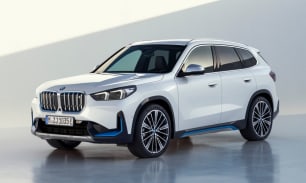Let’s make one thing clear. The Mach-E does not drive like a Mustang. A Mustang, of course, being characterized primarily by its brash V8 roar, gratuitous cabin and grand touring dynamics.
No, the Mach-E immediately reminds me of a Ford Europe SUV. Sounds like an insult doesn’t it? But it isn’t.
The Escape and Puma are remarkably sharp to drive, and I consider them deeply underrated options in the SUV space, and more suited to drivers than they first appear.
The Mach-E takes the best elements of these two and dials it up to 11, adding the smoothness of an electric powertrain and inherent rear-wheel drive performance characteristics as it does.
While it saddles you with a tall SUV-like seating position, it’s no simple SUV once you get it on a few curves, the urgent performance from the rear-mounted motor, even in the base car, is excellent, feeling as though it punches above many of its rivals, while the sharp, accurate steering makes it feel surprisingly agile and responsive considering its dimensions and weight.
The regenerative braking is well-calibrated, too, offered in either a one-pedal or more moderate tune, but perhaps the most surprising aspect of this car is its well balanced ride.
Reviews from my colleagues overseas pointed to an overly hard ride, which I was expecting, but I was greeted with a car that deals with bumps, undulations, and corrugations with a remarkable amount of poise.
Ford says what it calls the “Irish tune” was selected as it offered the best ride for our roads, and it seems the Blue Oval engineers weren’t wrong.
It’s a firmer ride than the boaty Hyundai Ioniq 5, but not as firmly sprung as the Polestar 2 or Tesla Model Y.
In other words, it’s firm enough to make it fun to drive, but not hard enough to ruin it in your day-to-day commute.
It was also interesting to find the MangeRide adaptive suspension in the GT grade didn’t make as big a difference as expected, firming things up a little on some surfaces, but offering a slight edge to the amount of chassis control on offer as a result.
The three drive modes also make a significant difference to the experience. The ‘Whisper’ mode dials back accelerator response and artificial noise, serving as a kind of ‘eco’ setting which is said to also be more suited to low-traction scenarios, where the instant torque of the electric motors can easily spin the wheels.
The standard mode is far more balanced, while the 'Untame' mode makes the motors respond in haste, and dials up the artificial rumbling noise, but not to an unpleasant level.
The fourth, ‘Untame Plus’ mode, only available on the top-spec GT, allows the car to, for example, break into a drift when grip is low enough by dialling back the traction control.
It’s designed to allow a little more play and maximise acceleration response for track use. Still, it doesn’t feel as tail-happy as its namesake combustion coupe.
While it appears to be yet another mid-size electric EV, then, there’s something a little more on offer here, and something which sets itself apart from the electric pack by being fun to drive in a way something like a Tesla Model Y isn’t.
The best part is, these unusually engaging dynamics extend beyond the top-spec GT, all the way to the base Select.
The only thing is, it’s still very tidy. It’s organised, the traction control is clever, the chassis is sharp, the steering is brilliant and the electric motors are… inorganic.
In some ways, this car is too good to be a Mustang, certainly missing some of the edge-of-your seat chaos a V8 rear-driven coupe can bring.
So, long as you understand this, there’s a very compelling sporty electric SUV to be found here.






















.png)







.png)


.png)

.png)

.png)


.png)

.png)

.png)
.png)
.png)





.png)





.png)












































.png)
.png)






.png)







.png)

























 copy.png)




















.png)


.png)






















